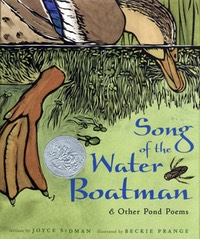 |
| Image courtesy Candlewick Press |
Review and Critical Analysis
Falling Hard is a collection of one hundred poems sent to editor Betsy Franco via email. The poems, written by teenagers , representing different ethnicities, genders, and backgrounds from all over the world, explore all aspects of falling into and out of love. Whether discussing admiration from afar, sex, or the devastation of a breakup, these teenage writers have captured what it means to be young and experience love.
Most of the poems in the collection are free verse poems, though an occasional sonnet does work its way in. They vary in length from four lines to two to three pages length, as well. The language varies in complexity, as one would expect from a wide variety of teenage poets, but most are filled with imagery and figurative language in attempts to define love. For example, in "Love Poem," the speaker compares his relationship to a tortilla, while in "Love is Like" love is compared to a honey bee. The authors use whatever they are familiar with to describe their love, from food to famous literary inspirations like Homer's Muse.
Because of the mature content and language, I would not recommend this book for classroom instruction, unless the teacher or librarian made a careful, intentional choice of a specific poem. Falling Hard is definitely a high school level book. For teens interested in poetry or who are dealing with love and relationships in any stage, I would highly recommend it for recreational reading.
Example Poems
Love is Like
by Hector Jasso, age 16
the sweetness of honey
falling from a bee hive.
You have to be careful
not to get stung.
Activity
Before reading this poem, ask students to brainstorm a list of things they use or encounter in their everyday life. They might come up with things like a desk, a baseball, or a microwave. They should record as many items and they can think of in their writing journal. After students have had a few minutes to brainstorm, read "Love is Like" two to three times. Invite students to share what they notice about the comparison in the poem and the author's use of opposites (or juxtaposition, depending on the age of the students).
As an extension, students could refer back to their list and choose an object to be the subject of their extended metaphor. Depending on the age and developmental stages of the children, you may want to give them a different emotion like joy, anger, or sadness. They could even include the use opposites in their comparisons.
Falling Hard is a collection of one hundred poems sent to editor Betsy Franco via email. The poems, written by teenagers , representing different ethnicities, genders, and backgrounds from all over the world, explore all aspects of falling into and out of love. Whether discussing admiration from afar, sex, or the devastation of a breakup, these teenage writers have captured what it means to be young and experience love.
Most of the poems in the collection are free verse poems, though an occasional sonnet does work its way in. They vary in length from four lines to two to three pages length, as well. The language varies in complexity, as one would expect from a wide variety of teenage poets, but most are filled with imagery and figurative language in attempts to define love. For example, in "Love Poem," the speaker compares his relationship to a tortilla, while in "Love is Like" love is compared to a honey bee. The authors use whatever they are familiar with to describe their love, from food to famous literary inspirations like Homer's Muse.
Because of the mature content and language, I would not recommend this book for classroom instruction, unless the teacher or librarian made a careful, intentional choice of a specific poem. Falling Hard is definitely a high school level book. For teens interested in poetry or who are dealing with love and relationships in any stage, I would highly recommend it for recreational reading.
Example Poems
Love is Like
by Hector Jasso, age 16
the sweetness of honey
falling from a bee hive.
You have to be careful
not to get stung.
Activity
Before reading this poem, ask students to brainstorm a list of things they use or encounter in their everyday life. They might come up with things like a desk, a baseball, or a microwave. They should record as many items and they can think of in their writing journal. After students have had a few minutes to brainstorm, read "Love is Like" two to three times. Invite students to share what they notice about the comparison in the poem and the author's use of opposites (or juxtaposition, depending on the age of the students).
As an extension, students could refer back to their list and choose an object to be the subject of their extended metaphor. Depending on the age and developmental stages of the children, you may want to give them a different emotion like joy, anger, or sadness. They could even include the use opposites in their comparisons.
















